If you’re in love with sarees and are looking to expand your current collection, then you’re at the right place.
Saree is an expression of the cultures and traditions that mark our country. The elegance of a saree is unmatched and that is why all of us love this special attire.
In this blog you’ll find some Famous Saree Brands In India that are very popular among everyone, and we can always name a few like the Kanjivaram Sarees, Bomkai Sarees, Bandhani Sarees etc. Well, there a more different India sarees you need to know about That You Must Add To Your Collection if you are a saree fan.
Here are all the different kinds of sarees you can get from across the India:
1. Kanjeevaram Saree
Place Of Origin
- Tamil Nadu
About
- It is considered as one of the most gorgeous saree all over the world. The Kanjeevaram get its name from the village called Kanchipuram. This gorgeous fabric is also known as Kanchipuram. These attractive sarees are made with a beautiful blend of colors and thick fabric. The touch of gold in Kanjeevaram sarees make them perfect for every occasion or celebration.

Weaving Process
- The silk that is used to produce Kajivaram sarees are obtained from the mulberry worms through the method of sericulture. About 250 to 300 threads are used to woven into the wept. This allows the saree to remain sturdy. The zari work used is generally gold and silver with silver running in first and coated with gold later.
Speciality
- The speciality of the saree lies texture, glimmer, permanence and refinement which is why it is popularly known as the queen of all sarees. The material used is the heavy Kanchipuram silk and is also a bit expensive because of its finesse and weight. The weight of the saree determines or is the sole parameter of its quality. The heavier the saree the better it is.
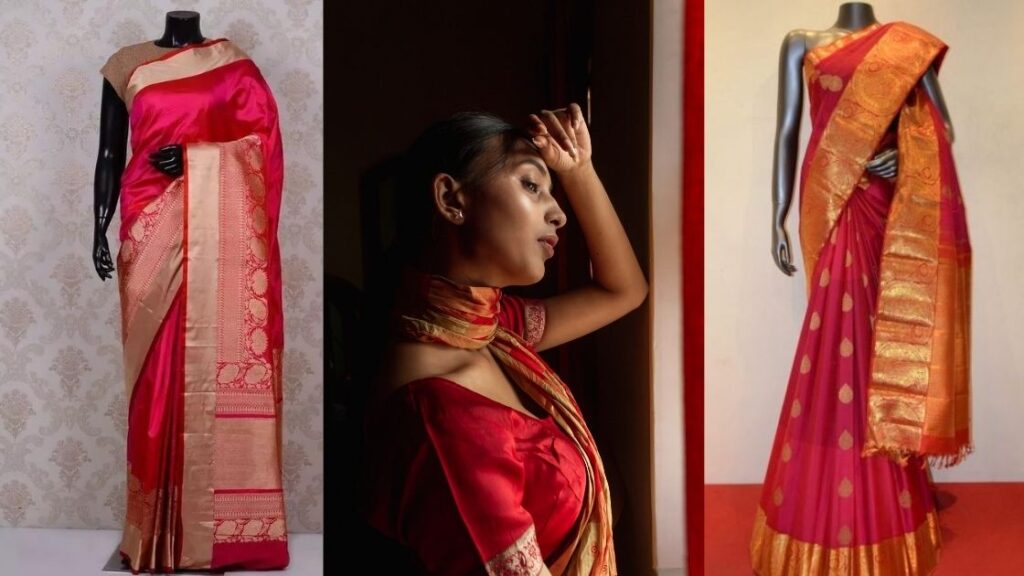
How To Maintain?
- Get your saree dry cleaned before you store it. …
- Remember to fold your saree carefully so as to not cause any damage to the zari work and change the folds every 3 months. …
- Don’t store your Kanjeevaram saree with other sarees. …
- Air your saree every 3 to 4 months.
Price Range
A basic Kanjeevaram saree costs around INR 7,000 and can go upto INR 2 lakhs as well.

Types Of Kanjeevaram Sarees
- Plain Kanchipuram Silk Saree with Gold Border
- Temple Border Kanchipuram Silk Saree
- Modern Kanchipuram Silk Sarees
- Traditional Kanchipuram Silk Saree
- Floral Weave Kanjeevaram Silk Sarees
Styling Tips
- The saree is usually coupled with gold jewellery to compliment the regal look of Kanjeevaram.
2. Bandhani Saree
Place Of Origin
- Gujrat
About
- Bandhani is a type of tie-dye textile decorated by plucking the cloth with the fingernails into many tiny bindings that form a figurative design. Bandhani is generally performed on cotton and silk fabrics. The fabric is tied tightly, and it is then dipped in for a dye bath. The tied area of the fabric is dyed in vibrant colors.
- Bandhani is generally made up of natural colors where the main colors are yellow, blue, green and black. Bandhani tends to lose its strength, if it is ironed on high heat so it is advised to dry clean or iron it on a low heat setting.

Weaving Process
- Art of Bandhani is a highly skilled process. Fabric to be dyed, is tied very tightly at different points, forming a pattern and it is then dyed in different colors. When this tied fabric is dipped for dyeing, the tied part does not catch color and remains of the same color as the fabric.
- Once the fabric is dyed, it is dried in open air and the drying process takes some time. In summers, Bandhani fabric is dyed in 4-5 hours; and in winters, it dyes in 6-7 hours. Depending on the pattern of the fabric it is tied in, it produces different designs like Bavan Baug, Chandrakala, Shikari etc.
Speciality
- The authentic Indian handicraft of bandhani is making a spectacular revolution and it is the most loved embroidery among women and holds a special space in their wardrobes. This precious art enhance not only the women’s cloth but also identified in the men’s ethnic closet too. The vibrant spectrum of colors and unique design patterns not only enhancing the beauty of the drapery but also providing a unique identity to the fabric.

How To Maintain?
- As It is a delicate fabric and needs to be stored and maintained carefully. Dry cleaning is the best way to take care of it and it must be stored properly so that it doesn’t lose its color or tensile strength.
Price Range
- Price of Bandhani Saree starts from INR 300 to INR 20000.

Types Of Bandhani Saree
- Jodhpuri Bandhej Saree
- Gujarati Bandhani Saree
- Bandhej Saree With Gota Work
- Bandhani Embroidery Saree
Styling Tips
- Bandhani Sarees can be worn with oxidized silver jewelry to jazz up the look. Add a potli bag for extra glam.
3. Bomkai Saree
Place Of Origin
- Odisha
About
- The Bomkai saree has been originated from a small picturesque village called Bomkai in Ganjam district, 156 Km from Bhubaneswar in Odisha. Later It is introduced in Sonepur. Bomkai can be explained as an extra weft technique on a pit loom. It is an outcome of Ikat and embroidery interwoven into each other. The borders are often in contrasting colors and the pallus marked by intricate threadwork.
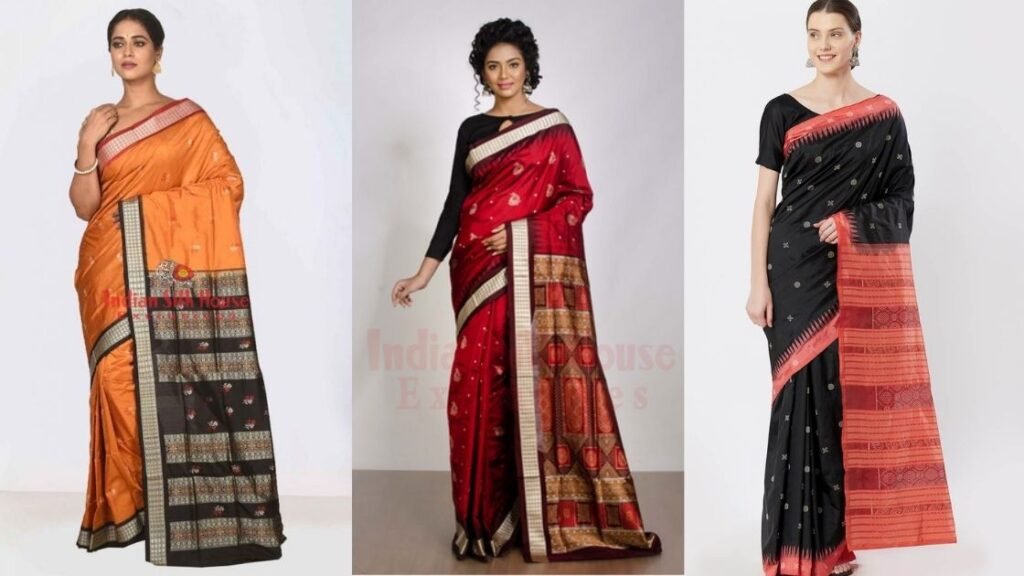
Weaving Process
- The weaving process starts only after coloring the threads, as far as the ‘Ikat’ system is concerned. The threads that are perpendicularly inserted into the ‘Handloom’ are the ‘Tana (twisted)’ and which are inserted parallel is the ‘Bana (Weft).
Speciality
- The most charming part is its thread work in the designs of the border and the palloo. The appearance of the saree is related to simplicity and has a tribal tinge in it. The sari is normally dyed to attain the red, black and white background colours.

How To Maintain?
- Always ensure your saree is absolutely dry before storage as moisture can damage the fabric
- Always keep the saree wrapped in Muslin cloth or pure cotton which lets the air to pass through but protects the saree from moisture.
- Store the saree in a dark and dry place to avoid eventual fading of the fabric
- Store it in a vertical, hanging position in your cupboard but refrain from using metal hangers as they can leave rust stains on the fabric
- Keep it away from your regular clothes, preferably in a long-term storage spot since it’s for special occasions and regular handling can leave unwanted spots on it
- Keep neem leaves in between the saree folds to preserve them from pests
- From time to time, change the saree folds to avoid creases that can wear and tear the fabric.
Price Range
- The price of Bomkai Sarees starts from INR 3000 to INR 21000.

Types Of Bomkai Sarees
- Sambalpuri Bomkai Saree
- Bomkai Patta Saree
- Cotton Bomkai Saree
- Bomkai Silk Saree With Ikkat Border
- The Khaki Bomkai Saree
- The Indian Art Bomkai Saree
- The Handloom Bomkai Saree
- The Box Bomkai Saree
Styling Tips
- Wear it to work or casual events. Add some silver or golden jhumkas for a complete look.
4.Tant Saree
Place Of Origin
- West Bengal
About
- Tant saree is a traditional Bengali sari loved by most women. It is also known as Jamdani Tant. The term “tant” refers to the handlooms in Bengal that are used to weave cotton sarees along with dhotis and other garments. Typically, worn during hot climates, this saree is made of cotton and is considered as iconic drapes.
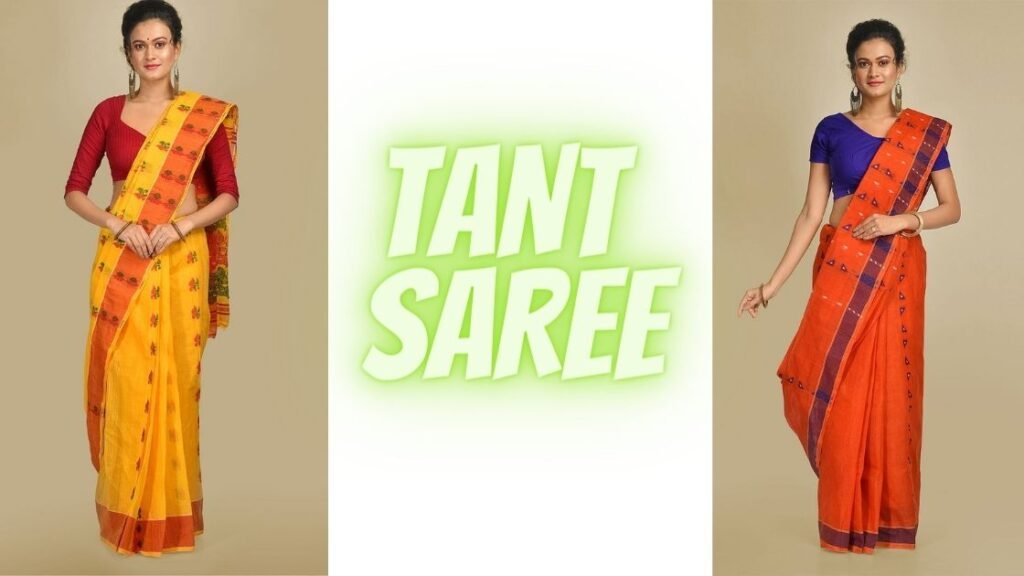
Weaving Process
- Weaving of tant sari is famous and an age old crafting of Bengal. The craftsmen deftly weave the cotton to thread which is woven to tant sari. Two shuttles are used for this purpose. Traditionally, handlooms were used by the weavers, which have today been largely replaced by power looms to weave these saris.
Speciality
- Tant sari are woven from cotton threads and distinguished by its lightness and transparency. It is considered to be the most comfortable sari for the hot and humid climate in the Indian subcontinent.

How To Maintain?
- Soak the saree in rock salted warm mater before the first wash.
- Wash with mild detergents followed by use of starch.
- Hang them to dry in a shaded area after washing.
- With the use of Charak tant sarees can gain a new look.
Price Range
- The price of this saree starts from INR 800 to INR 4000.

Types Of Tant Saree
- Jamdani Tant Saree
- Cotton Tant Saree
- Banarasi Tant Saree
- Dhakai Tant Saree
- Manipuri Tant Saree
- Handloom Tant Saree
- Baluchari Tant Saree
- Wooden Tant Saree
- Santipur Tant Saree
- Fancy Tant Saree
- Soft Tant Saree
- Tant Silk Saree
Styling Tips
- You can wear a Tant Saree with a high bun or loose curls for the perfect festive look. Elevate your look with heavy accessories.
5.Chikankari Saree
Place Of Origin
- Lucknow
About
- Chikankari is a traditional style of embroidery from the Indian city of Lucknow. Further, it is one of the popular and best textile decoration styles. The main market for local chikan work is located in Chowk, Lucknow. The work of creating the chikan work on fabric is called Chikankari.
- But, there are many stories about the origin of the chikan embroidery work in India, the most popular one is about Noor Jahan. This Mughal empress and wife of Emperor Jahangir introduced the Chikankari technique to India. Lucknow is the main place for the Chikankari industry.
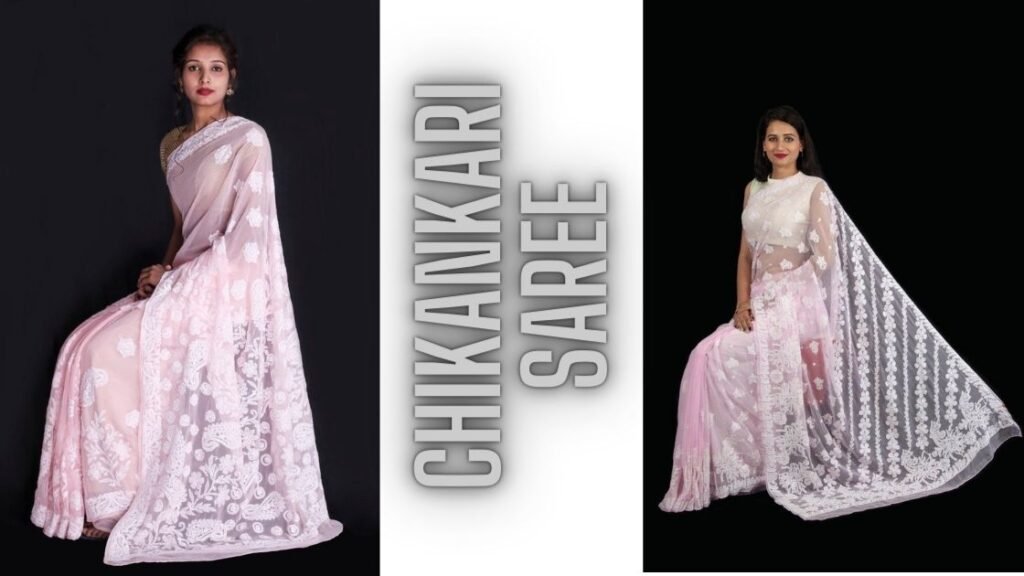
Weaving Process
- Indian Chikan work basically involves a series of processes from cutting, stitching to printing, embroidery, washing and finishing. The same person performs cutting and stitching of the cloth and sewing together the cut parts of the fabric. Next, it consists of printing using wooden blocks which is the best method of printing.
- Afterwards, the women generally indulge in the intricate artwork of embroidery. It is later washed and finished by soaking in acid treatment, bleaching, stiffening, and ironing. This is done in 10 to 12 days, however, the entire process of creating a unique chikankari textile garment takes about one to six months.
Speciality
- Traditionally, the craft work was done on white muslin cloth using white thread. Now the embroidery is done on pastel shades of muslin and cotton. It is also embellished and adorned with sequin, beads and mirror work to enrich its appearance.
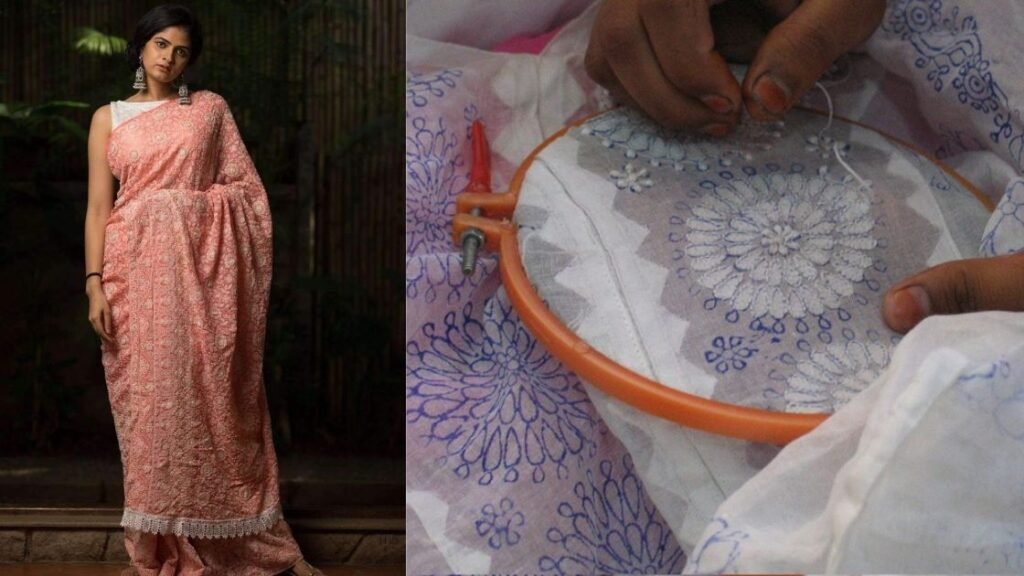
How To Maintain?
- Silk should be dry cleaned
- Cotton can be hand washed using mild soap
- Do not dry the sarees in the sun, as the color can fade
- Do not keep it in the closet in the same condition for a long period
Price Range
- The Price of Chikankari Saree starts from INR 2000 to INR 20000.
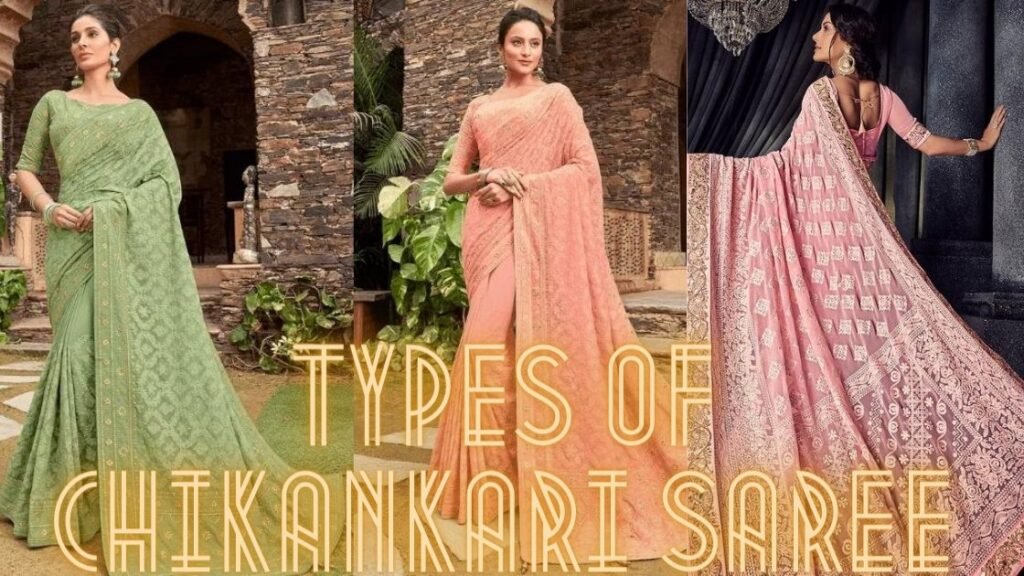
Types Of Chikankari Saree
- Pure Georgette Chikankari
- Faux Georgette Chikankari
- Kota Chikankari Saree
- Net Chikankari Saree
- Cotton Chikankari Saree
- Chanderi Chikankari Saree
Styling Tips
- A timeless piece of fashion, Chikankari sarees can be styled with straight hairstyles and minimal jhumkas.
So, that’s all about this blog.
I hope you find this above article Famous Saree Brands In India helpful, if yes then do not forget to share and comment. And If I have missed out something then comment in the below box so that I can update that information in my blog. Thank you for your time you spend in this blog.